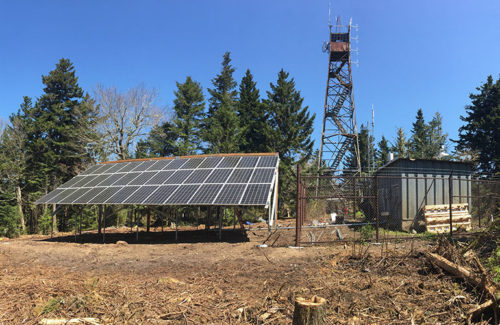Among the tulip trees, red oaks and Carolina silverbells of Mt. Sterling, a peak in Great Smoky Mountains National Park, stands a 60-ft communications tower. That tower’s a 3.5-mile hike through North Carolina backcountry to the nearest road, and those miles leading back to civilization were, until recently, traced by a lone powerline that connected the tower to the electric grid of Haywood County, North Carolina.

The completed 10-kW solar+storage microgrid atop Mt. Sterling sits next to the communications tower it powers. Great Smoky Mountains National Park
The sole purpose of that electric line was to provide energy to the remote communications building, which was formerly used by firewatch personnel, to power a radio repeater relay for that region of the national park.
“Having the line going up the mountain for that long, through all that vegetation in the national park, there was a lot of reliability issues, and these issues were triggered when there was an outage,” said Sherif Abdelrazek, senior engineer at Duke Energy, the utility servicing the line.
As technology advanced, maintaining that powerline made less and less sense.
“The radio repeater is not a huge consumer of electricity. It’s a very important component of our radio system, but you can imagine our monthly electric bill from Duke was not a big number,” said Mark Collins, environmental protection specialist at Great Smoky Mountains National Park. “Part of the line within the park runs along a gravel road and then it goes up to the top of the mountain. As it starts up the mountain it goes through some very steep terrain. It’s just a lot of work for a little bit of electricity and a lot of safety issues.”

From atop the communications tower on Mt. Sterling, clouds are seen settled among the peaks of the Smoky Mountain Range. Great Smoky Mountains National Park
The 13 acres of land the power lines sat on belongs to the National Park Service, but Duke Energy was responsible for its maintenance. That meant the utility company had to keep vegetation away from the lines and occasionally replace poles. To do maintenance in the steep terrain of Mt. Sterling backcountry, supplies would often need to be flown in by helicopter or hauled up by pack mule, Collins said. Permitting is also needed every time maintenance is required in the park.
Duke Energy sought an off-grid alternative for the communications tower. The utility, in partnership with the National Park Service, was able to free 13 acres of Smoky Mountain forest of powerline by building a solar+storage microgrid instead. This gave the communications tower the power it needed to keep the radio on and also granted it energy independence.
“[Duke] made a significant investment in the microgrid itself, but I think they’ll reap the return on investment by the reduced maintenance, because some of those poles needed to be replaced in the near future,” Collins said. “There was some expensive maintenance getting ready to come down the pike.”

Plant life surrounds the microgrid installed on Mt. Sterling to power its radio relay communications tower. Installing the solar+storage array eliminated 3.5 miles of powerline that originally ran up the mountain and powered the tower. Great Smoky Mountains National Park
Duke Energy hired Fluidic Energy (now acquired by NantEnergy) as general contractor and Sky Renewable Energy and Industrial Solar Consulting as subcontractors for the project.
The communications tower is now powered by a 10-kW solar array paired with a Fluidic Energy 95-kWh zinc-air battery that was installed in Spring 2017.
The solar array is composed of 36 SolarWorld panels, mounted with Milspec Earth Anchors helical screws next to the communications tower. The 350-W modules face south at a 30° tilt. The array is equipped with a GE inverter, a Fluidic Energy Data Acquisition System and a Fluidic Energy hybrid battery stack.
Installing a microgrid in this remote location posed its own challenges. The microgrid installers tried to create minimal disturbances during construction to preserve the natural wilderness experience of backcountry camping in the area.
“We have very detailed environmental studies to make sure that we’re not negatively impacting the land,” Abdelrazek said. Supplies for the microgrid were flown in by helicopter.
Power lines were removed in November 2018, and the land is now left to return to a natural state.
“It benefits us because we’re removing unnatural governance from an area that we can now allow go back to its natural state,” Collins said. “I think visitors will benefit because that visual of a power line will no longer be there.”




Loved this article! I wish more national parks would consider alternatives to unsightly powerlines